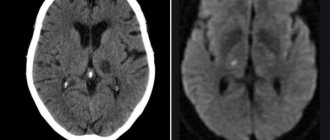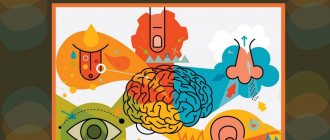In order for a sensation to arise as a result of the action of a stimulus on the sense organs, it is necessary that the stimulus causing it reaches a certain value or threshold of sensitivity. There are two types of sensitivity thresholds: absolute and differential (or discrimination sensitivity threshold).
The lowest strength of the stimulus at which a barely noticeable sensation occurs is called the lower absolute threshold of sensation .
The lower threshold of sensations is opposed by the upper threshold. The greatest strength of the stimulus, at which a sensation of this type still occurs, is called the upper absolute threshold of sensation . The upper threshold limits sensitivity on the greater side, and up to a certain limit, above which pain occurs or there is no change in the intensity of sensations.
Thresholds of sensations are individual for each person and change throughout his life. Sensations, in addition to the magnitude of the absolute threshold, are also characterized by a threshold for discrimination, which is called the differential threshold.
Differential threshold is the smallest value of differences between stimuli when the difference between them is still perceived. The differential threshold of sensations for different sense organs is different, but for the same analyzer it is a constant value.
The Bouguer-Weber law states: the differential threshold of sensation is different for different sense organs, but for the same analyzer it is a constant value. The constant itself is called the Weber constant.
The values of the Weber constant for various senses are given in the table:
| Feel | Constant value |
| Changing pitch | 0,003 |
| Changing the brightness of the light | 0,017 |
| Change in pressure on the surface of the skin | 0,140 |
| Changing the weight of an item | 0,020 |
| Changing the sound volume | 0,100 |
Lower and upper absolute thresholds of sensation (absolute sensitivity) and differential thresholds of discrimination (relative sensitivity) characterize the limits of human sensitivity .
Along with this, operational thresholds of sensations - the magnitude of the signal at which the accuracy and speed of its discrimination reaches a maximum. This value is an order of magnitude larger than the discrimination threshold and is used in various practical calculations.
Pathological changes in sensitivity thresholds include a decrease in sensitivity thresholds - hyperesthesia, an increase - hypoesthesia, complete loss - anesthesia and perversion - senesthopathy, psychotic states (acute hallucinosis, paranoid, etc.), initial manifestations of non-paroxysmal clouding of consciousness (delirium, oneiroid, amentia).
Hyposthesia is a decrease in susceptibility to external stimuli, when the surrounding world, individual objects and properties lose their brightness, colorfulness, richness, and distinct individuality. Occurs in cases of stupor, depressive states, hysterical syndromes, alcohol and drug intoxication.
Hyperalgesia is an increase in pain sensitivity, observed in various pathological conditions, in particular with depression, especially masked depression (“algic melancholia” (Petrilovich, 1970)).
Anesthesia is manifested by anatomical and functional damage to the analyzer, starting from the receptor section and ending with the cortical representation, which is clinically accompanied by loss of skin sensitivity, loss of taste, smell, blindness, and deafness.
In neurology, visual agnosia (failure to recognize visual images, letters, words), auditory (failure to recognize objects when palpating), autotopoagnosia (failure to recognize parts of one’s body), anosognosia (failure to recognize illness, injury), and facial agnosia are distinguished. In hysterical neurotic syndromes, mental amblyopia (blindness), mental anosmia (insensitivity to smells), mental ageusia (loss of the sense of taste), mental deafness, mental tactile and pain anesthesia (analgesia) are observed.
Attention. Pathology of attention
Attention is the direction and concentration of consciousness.
Properties of attention:
1. Stability – the duration of maintaining intense attention.
2. Switching attention is a deliberate transition from one object to another.
3. Distribution of attention - simultaneously successfully performing two or more types of activities.
4. Volume of attention – the number of objects of attention simultaneously held in consciousness.
Types of attention:
- voluntary (the highest type of attention is active attention)
- involuntary (determined by the psychophysiological characteristics of a person and the qualitative characteristics of the stimulus).
Theories of attention:
— Motor theory ( R. Descartes ). Since the state of attention can be caused by volitional effort, Descartes suggested that such effort must be exclusively muscular
— Attention as a result of limited consciousness. ( Herbert and Hamilton ). They noticed that if one of the ideas is most intense, then all others are repressed from consciousness. A person focused on a certain thought or perception does not hear or notice anything extraneous in relation to the object of attention and turns out to be, as it were, “blind” and “deaf” to the entire world around him.
— Activation theory ( Lindsley ). Human behavior is determined by fluctuations in arousal. The lower limit is sleep, the upper limit is hyperexcitation. Between sleep and states of extreme arousal, there are a number of levels that make up the range of intensity of behavior. A certain segment of this range corresponds to the highest performance, which represents attention.
— The principle of dominance ( A.A. Ukhtomsky ). The excitatory process can create a temporary focus of excitation that summarizes and accumulates impulses flowing into the central nervous system, while simultaneously suppressing the activity of other centers.
Attention is the ability to concentrate on any external or internal events, objects or activities. Attention contributes to a sustainable increase in the level of sensory, intellectual and motor activity, ensuring the productivity of mental activity. Attention does not have its own, separate and specific product. Its result is the improvement of any mental activity to which it is connected.
There are active (voluntary) and passive (involuntary), post-voluntary attention. Among the properties of attention are stability, volume, switchability, and direction.
Attention disorders include:
- absentmindedness - impaired ability to maintain focus for a long time;
- exhaustion - weakening of the intensity of attention, rapid transition of active attention to passive;
- distractibility - increased mobility, rapid changes in direction, concentration, intensity of attention;
- stiffness - inertia, fixed attention, with difficulty switching from one object to another;
- narrowing of the scope of attention is a pathological concentration caused by the weakness of its distribution between objects.
Attention disorders are part of all positive and negative syndromes.
Literature
- MG Khrenova, AV Bochenkova, AV Nemukhin. (2009). Modeling reaction routes from rhodopsin to bathorhodopsin. Proteins
.
78 , 614–622; - Feldman T.B., Kholmurodov Kh.T., Ostrovsky M.A., Khrenova M.G., Nemukhin A.V. (2009). Study of the conformational state of the chromophore group, 11-cis-retinal, in rhodopsin using computer molecular modeling methods. "Biophysics". 54, 660–667;
- Khrenova MG, Bochenkova AV, Nemukhin AV Theoretical characterization of bathorhodopsin. In: Molecular simulation in materials and research biological / ed. by Kh.T. Kholmurodov. Nova Science Publishers, 2009. P. 19–27;
- Nobel Prize in Chemistry (2012): for the receptors of our first, third and fourth senses;
- Visual rhodopsin is a receptor that responds to light;
- Receptors in active form;
- The triumph of computer methods: prediction of protein structure;
- Molecular dynamics of biomolecules. Part I. History of half a century ago.
Imagination and representation.
Imagination and representation are tools for reflecting and designing the world around us.
Imagination is a mental cognitive process of creating new ideas based on existing experience, that is, a process of transformative projection of reality.
Imagination is a reflection of external space in new unusual combinations and connections. It occupies an intermediate position between perception and thinking, thinking and memory. This is one of the most mysterious psychic phenomena. We know almost nothing about the mechanism of imagination, its anatomical and physiological basis.
Imagination is unique to humans. It allows him to go beyond the real world in time and space, giving him the opportunity to imagine the finished result of his work even before starting work. Almost all human material and spiritual culture is a product of people's imagination and creativity.
Involuntary imagination is also called passive or unintentional imagination - this is the creation of new images without any external stimuli. It consists in the emergence and combination of ideas and their elements into new ideas without a specific intention on the part of a person, with a weakening of conscious control on his part over the course of his ideas.
It appears most clearly in dreams or in a half-asleep, drowsy state, when ideas arise spontaneously, replace, combine and change on their own, sometimes taking on the most fantastic forms.
Voluntary imagination , or, as it is also called, active or deliberate imagination, is the creation of new images through volitional efforts. It represents the deliberate construction of images in connection with a consciously set task in one or another type of activity.
Representation is the process of mentally recreating images of objects and phenomena that currently do not affect the human senses.
In accordance with the division of views by types of the leading analyzer, the following types of views are distinguished:
— visual (image of a person, place, landscape);
- auditory (reproduction of a musical melody);
- olfactory (ideation of some characteristic smell - for example, cucumber or perfume);
- gustatory (ideas about the taste of food - sweet, bitter, etc.)
- tactile (idea of the smoothness, roughness, softness, hardness of an object);
- temperature (idea of cold and heat);
However, often several analyzers are involved in the formation of representations. Thus, imagining a cucumber in one’s mind, a person simultaneously imagines its green color and pimply surface, its hardness, characteristic taste and smell.
Ideas are formed in the process of human activity, therefore, depending on the profession, predominantly one type of ideas develops: for an artist - visual, for a composer - auditory, for an athlete and ballerina - motor, for a chemist - olfactory, etc.
Ideas also differ in the degree of manifestation of volitional efforts. In this case, they are divided into involuntary and voluntary. Involuntary ideas are ideas that arise spontaneously, without activating the will and memory of a person, for example, dreams.
Arbitrary ideas are ideas that arise in a person under the influence of the will, in the interests of the goal he has set. These ideas are controlled by a person’s consciousness and play a large role in his professional activity.
Study methods
Research methods:
- Boundary method. The researcher influences the experimental subjects with different stimuli, gradually reducing the intensity. The subject must respond when he no longer feels the influence from the outside. This is how the boundaries of perception are determined.
- Method of constant stimuli. The experimental subject is exposed to various stimuli over a wide range. The subject must answer what he feels and at what moments.
- Average error method. This is a procedure for equalizing incentives. The intensity of the effect on the body is slowly raised to a noticeable level.
Methods are often used in a comprehensive manner to obtain more accurate information.
Thinking. Intelligence. Pathology of thinking
Thinking is a person’s ability to acquire new knowledge bypassing the senses.
2 sides of thinking (phenomenon of the human psyche):
1) A property extracted from a specific fact is recognized as equivalent to the fact.
2) The selected property leads to a certain conclusion that cannot be obtained directly from the fact.
Thinking obeys the laws of logic. The main logical forms are:
— Concept (a thought that includes essential features of an object)
— Judgment (reflection of the connection between concepts)
— Inference (judgment based on other judgments)
The thinking process includes:
— Synthesis (combining information into a whole)
— Comparison (establishing similarities)
— Generalization (highlighting the general, specifying)
Thinking is not needed if there is no goal. The need to think arises when a problem appears. The problem is transformed into a task, i.e. into a specific task.
Types of thinking:
— Visually effective (pragmatists)
— Figurative (poets)
— Abstract (philosophers)
Thinking is the main component of intelligence (mind, thinking abilities). The individual characteristic of thinking, that is, thinking in action, the quality of the mind (intelligence), includes breadth, depth, independence, criticality and flexibility, consistency and speed of mental operations. Intelligence itself, the ability to form new conclusions and grasp different points of view, includes the prerequisites of intelligence (memory, attention, speech, etc.), spiritual inventory (stock of knowledge and skills).
a) Acceleration of thinking is observed in manic states and is characterized by verbosity, distractibility, and the superficial nature of associations. Judgments arise easily, are frivolous, superficial, and the depth of thought suffers. Acceleration of thinking to a pronounced degree reaches a “jump of ideas”, speech does not keep up with thoughts and can be outwardly incoherent (“manic confusion”)
b) inhibited (slow) thinking is observed in depression, states of deafness, epilepsy, organic brain damage, and is characterized by a poverty of associations, judgments are formed with difficulty, speech is laconic, monosyllabic.
“Schizophasia” is a form of speech disorders against the background of clear consciousness (as opposed to amentive, incoherent thinking) that appears in the meaningless “stringing” of individual words, names, terms that do not have “grammatical coherence and logical sequence.
2. Isomerization reaction with thermal activation
The previous section talked about the isomerization of retinal upon absorption of a light quantum (that is, this is an elementary act of vision). But what about temperature activation leading to “dark noise” of rhodopsin?
We tried to apply the QM/MM method to this problem as well, in order to follow the elementary event of rhodopsin activation not by light, but by elevated temperature. For this purpose, a study of the intermediate state between rhodopsin and bathrodopsin was carried out. Analysis of the vibrational structure of the spectrum shows that it is characterized by the presence of one imaginary frequency (283i cm−1), corresponding to vibrations in the region of the isomerizing double bond (Fig. 8).
Figure 8. Vibration shape corresponding to the imaginary vibration frequency 283i cm−1 in the transition state
A feature of the geometric configuration of the transition state is the almost straight dihedral angles C10-C11=C12-C13 and H-C11=C12-H and the changed bond order (that is, the isomerizing bond can actually be considered a single bond). Such signs indicate the possibility of a biradical nature of the transition state.
Within the framework of the unrestricted Hartree-Fock method, orbitals were obtained, the peculiarity of which is that almost all orbitals of the conjugated π-system are localized on one side of the C11=C12 bond (either on the side of the β-ionone ring or on the side of the protonated Schiff base). Using this approximation as a starting one for calculating CASSCF showed that the dominant one in the ground state is the CSF, in which 10 electrons are paired in the 5 lower orbitals of the active space, and the remaining two are paired and occupy spatially separated orbitals (Fig. 9).
Figure 9. Singly occupied orbitals in the transition state structure
The summation of the Mulliken charges showed that in such a structure there is no transfer of positive charge towards the β-ionone ring, that is, the formation of a single C11-C12 bond from a double bond occurs through homolytic cleavage of the double bond. The result of calculating the spin density confirms the assumption of a biradical character.
To study isomerization, a singlet biradical solution was constructed in which two unpaired electrons were in spatially separated orbitals (similar to Fig. 9). The energy barrier of the isomerization reaction on the surface of the ground electronic state is 26 kcal/mol, and the true activation energy, taking into account the difference in the energies of zero-point vibrations of the reagent and the activated complex, is 23 kcal/mol. This result is in good agreement with the results obtained in the experiment (20–25 kcal/mol).
From the resulting transition state, a vibrational mode corresponding to a single imaginary frequency was descended, followed by energy minimization. The geometric configuration of the stationary point obtained in this way coincides with the equilibrium geometric configuration obtained by optimizing the geometric parameters of the SAR structure. Thus, the primary stable intermediate of the photoinduced and thermally activated process coincides.
When comparing the calculated and experimental enthalpies of the rhodopsin → batorhodopsin transition, we have already discussed the shortcomings of the experiment and its inconsistency with the results obtained in similar systems. Now these arguments are supplemented by data obtained from studying the reaction during thermal activation. If it is known that the true activation energy is 23 kcal/mol, then the product, that is, batorhodopsin, cannot lie above rhodopsin by 32 kcal/mol, that is, 6–9 kcal/mol above the transition state of the thermal reaction (Fig. 10) .
Figure 10. Scheme of a photoinduced reaction (dashed line) and a reaction during thermal activation in the ground electronic state (solid line)
* * *
To summarize, detailed information has been obtained on the structure and properties of rhodopsin and bathrodopsin. The cis-trans isomerization reaction during thermal activation in the ground electronic state was also characterized and it was established for the first time that the primary intermediate of both the photoinduced and thermally activated reactions is batorhodopsin. All these results were obtained based on the analysis of structures only in the ground electronic state, as well as from the calculation of spectral properties and consideration of the features of electronic configurations at stationary points. This method of studying has proven itself for such a well-studied system as rhodopsin and has allowed us to obtain a number of new results, in particular regarding the cis-trans isomerization reaction that underlies our vision.
Emotions. Pathology of emotion.
Emotions are a person’s subjective experience, his attitude to reality.
Emotions include:
— Emotion itself (a person’s evaluative reaction to reality);
— Affect (strong, violent, short-term experience);
— Passion (strong, persistent, long-lasting experience)
— Mood (a long-term emotional state that colors a person’s behavior);
— Feeling (stable mental state of an objective nature);
— Stress (nonspecific response of the body to any demand presented to it).
Theories of emotions:
— Theory of limited sensations (James).
— Energy theory of emotions (E. Gelingor) “Emotion carries out the energetic mobilization of the body.”
— Regulatory theory of emotions (P. Anokhin) “Emotion is a mechanism that keeps life processes within optimal boundaries.”
— Theory of mismatch (P. Simonov) “Emotions arise when there is a mismatch between a vital need and the possibility of satisfying it.”
Emotion is considered as a generalized assessment (reaction) of a person to a situation.
Physiological affect is a state of expressed affect (anger), not accompanied by clouding of consciousness, but only by a possible narrowing of the range of ideas concentrating on events associated with the emerging affect; the episode does not end with sleep, severe psychophysical exhaustion and amnesia. In this state, illegal actions are often committed. These persons are recognized as sane, in contrast to those who have suffered pathological affect.
Pathological affect is a short-term mental disorder with aggressive behavior and an irritable-angry mood against the background of twilight stupefaction. This state occurs in response to intense, sudden mental trauma and is expressed by a concentration of consciousness on traumatic experiences followed by an affective discharge, followed by general relaxation, indifference and, often, deep sleep. Characterized by partial or complete amnesia. Persons who have committed offenses in this state are considered insane.
Violation of the strength of emotions:
1. Sensitivity (emotional hyperesthesia) – increased emotional sensitivity, vulnerability. It may be an innate personality trait, especially pronounced in psychopathy.
2. Emotional coldness – leveling the expression of emotions in the form of an even, cold attitude towards all events, regardless of their emotional significance. Identified in psychopaths and schizophrenia.
3. Emotional dullness - weakness, impoverishment of emotional manifestations and contacts, impoverishment of feelings, reaching the point of indifference. Occurs within the framework of a schizophrenic defect.
4. Apathy is indifference, a complete absence of feelings, in which desires and impulses do not arise. More often there is sensory dullness, in which emotions become dull and poor. The predominant emotion of patients is indifference. It occurs in schizophrenia (defect) and gross organic brain lesions, and can also be a leading manifestation of depressive syndrome.
Violations of emotional stability.
1. Emotional lability is a pathologically unstable mood that easily changes to the opposite due to a change in the situation. Pathologically unstable mood is characteristic of asthenic syndrome; in addition, it can occur within the framework of emotional-volitional disorders in personality pathology.
2. Explosiveness – increased emotional excitability, in which the experience of frustration, anger, even rage, with aggressive actions easily arises. It may arise for a minor reason. Explosiveness is characteristic of emotional-volitional disorders in personality pathology and organic (traumatic) brain lesions.
3. Weakness - a state of easily fluctuating mood for an insignificant reason from tearfulness to sentimentality with tenderness. May be accompanied by moodiness, irritability, and fatigue. It is observed with vascular damage to the brain, with somatogenic asthenia.
Adaptation
Adaptation is the body’s getting used to the influence of certain stimuli. Kinds:
- Complete loss of sensation due to prolonged, intense exposure to irritants.
- Dulling of the senses due to strong exposure to external stimulants.
- Increased sensitivity due to weak exposure to unpleasant factors.
In psychology, several thresholds are identified, at each of which a person experiences different sensations from the influence of external stimulants. When studying them, you need to take into account a number of factors that influence the manifestations of feelings in order to understand what will happen in similar situations in the future.
Will. Motivation. Pathology of will
Will as a human quality is the ability to make choices and take actions.
Will (psychology) is a property of a person, which consists in his ability to consciously control his psyche and actions.
It manifests itself in overcoming obstacles that arise on the way to achieving a consciously set goal. Positive qualities of will and manifestations of its strength ensure the success of activities. Strong-willed qualities often include courage, perseverance, determination, independence, self-control and others. The concept of will is very closely related to the concept of freedom.
Willpower - This is the inner strength of the individual. It manifests itself at all stages of the volitional act, but most clearly in what obstacles were overcome with the help of volitional actions and what results were obtained. It is obstacles that are an indicator of willpower.
Motivation (from Latin movere) - an incentive to action; a dynamic psychophysiological process that controls human behavior, determining its direction, organization, activity and stability; a person's ability to actively satisfy their needs.
Hypobulia is a decrease in volitional activity, accompanied by poverty of motives, lethargy, inactivity, poor speech, weakened attention, impoverished thinking, decreased motor activity, and limited communication.
Abulia - lack of motivations, interests, desires, and desires. It is observed in chronic diseases with decreased intelligence and weakened affective activity. Often combined with symptoms such as:
Decrease in social productivity - deterioration in the performance of social roles and skills, i.e. functionally organized behavioral traits shared by the majority of individuals occupying a certain social position and considered as essential for maintaining this position,
Decrease in professional productivity - deterioration in the performance of professional duties and skills, i.e. specific tasks and responsibilities, knowledge and standards in the professional field and its productivity (material production, service, science and art),
Social alienation is a form of behavior characterized by a persistent tendency to withdraw from social interactions and connections. In the individual's culture, such behavior is usually viewed as abnormal, indicating the presence of a mental disorder or abnormal personality traits.
The pathology of lower volitional activity includes the pathology of drives formed on the basis of instincts. They occur in the form of strengthening, weakening or perversion of instincts.
Sensitivity thresholds










